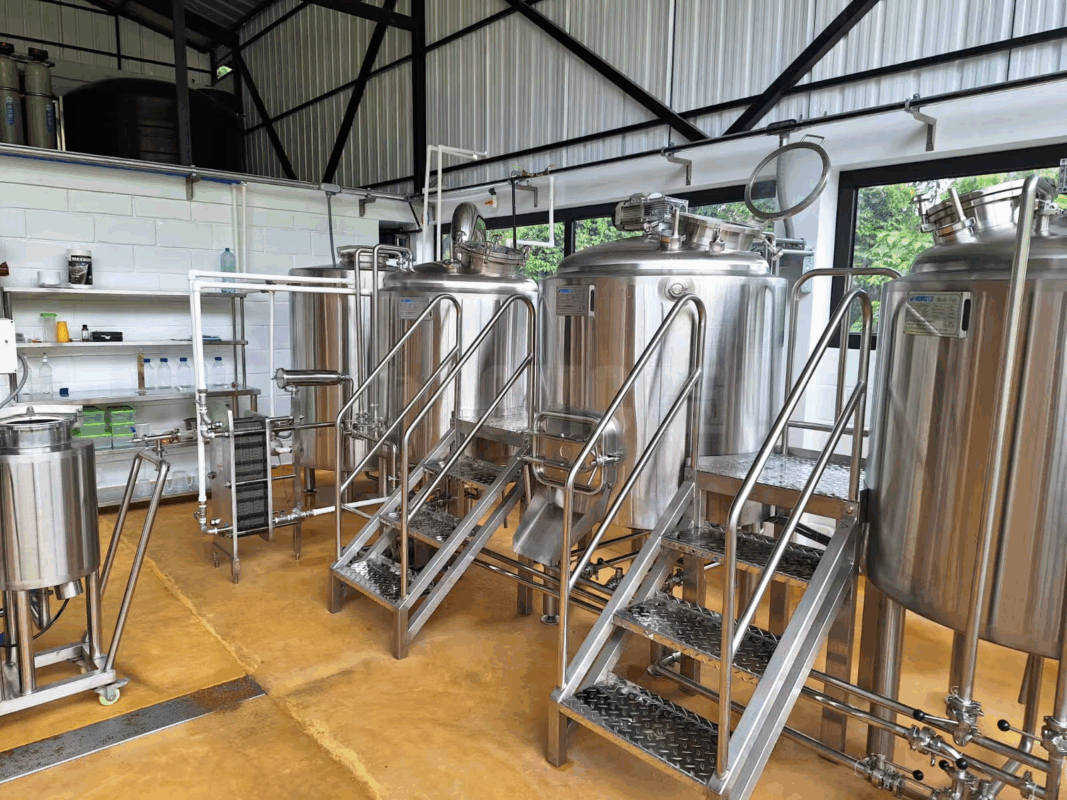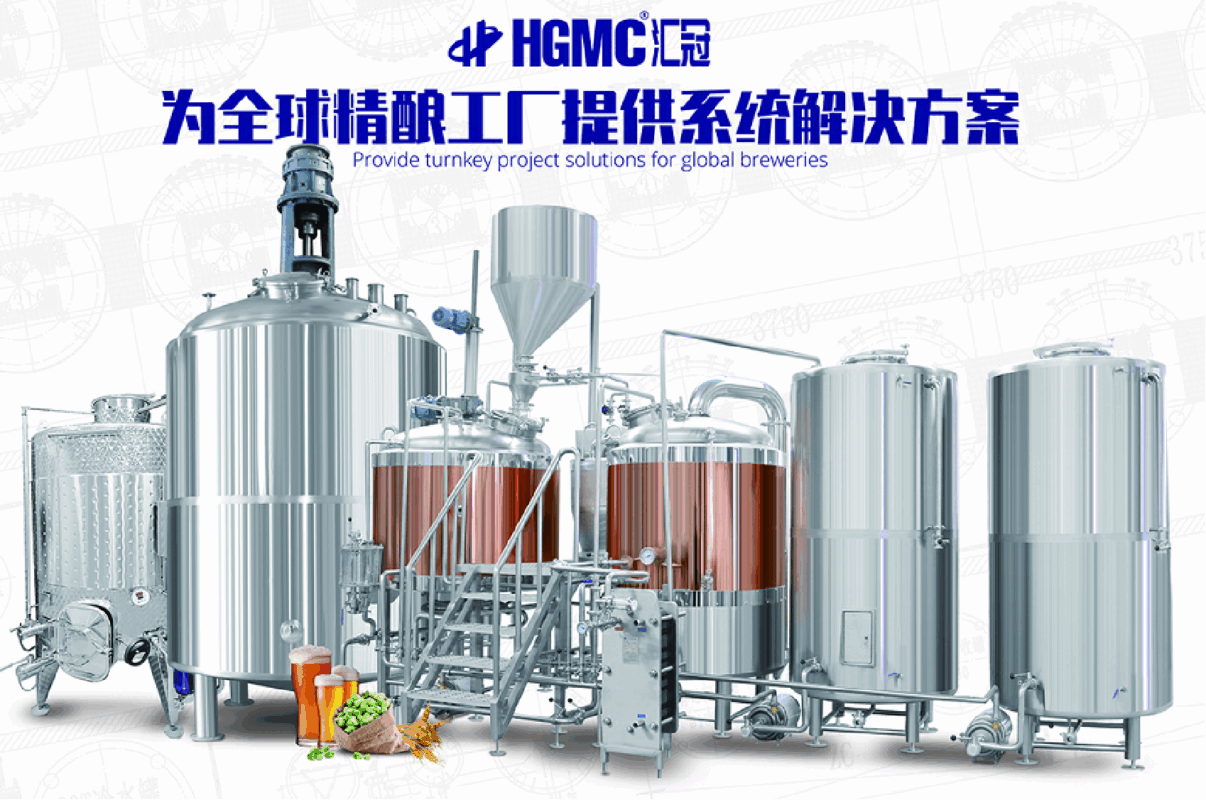In recent years, craft beer has rapidly gained popularity worldwide. People’s demand for beer is no longer limited to quenching thirst or socializing—more and more consumers are seeking personalized flavors, unique tastes, and premium quality in their brews. This trend has directly driven the development of the beer brewing industry and made “beer brewing equipment” a central focus. For home enthusiasts, small bar owners, and even investors in large breweries, choosing the right beer brewing equipment is the very first step toward success.

Main Components of Beer Brewing Equipment
Mashing System
The mashing system marks the beginning of the beer brewing process and is one of its most critical stages. It mainly consists of a mash tun, lauter tun, brew kettle, and whirlpool. After the malt is crushed, it is mixed with hot water in the mash tun to convert starches into fermentable sugars. The wort is then separated from solid residues in the lauter tun before being transferred to the brew kettle, where it is boiled with hops to develop the aroma and bitterness.
For home brewing enthusiasts, a small, all-in-one mashing system is usually sufficient. This type of equipment integrates multiple functions into a single container, making it simple to operate and space-efficient. For bars or small breweries, multi-tank, separated mashing systems are more suitable, as they allow higher production capacity and greater flexibility in the brewing process.
Fermentation System
Fermentation determines the beer’s flavor and alcohol content, making it the soul of the brewing process. The core of the fermentation system is the fermentation tank, typically equipped with a cooling jacket, temperature probe, and pressure regulation valve. High-quality fermentation tanks maintain a consistent temperature, allowing yeast to work under optimal conditions and produce unique flavors.
In home brewing, plastic or glass fermentation buckets are commonly used. They are affordable and suitable for small-batch experimentation. Bars and breweries, however, tend to use stainless steel conical fermentation tanks. These tanks are not only more durable but also facilitate the removal of sediment and yeast, improving fermentation quality and hygiene.
Cooling and Temperature Control System
After fermentation, beer needs to be cooled quickly to prevent contamination and flavor degradation. Common cooling equipment includes plate heat exchangers and chillers. For small-scale systems, ice baths or simple cooling coils can achieve the desired temperature reduction, though efficiency is limited. In industrial production, cooling systems are usually equipped with automated temperature control to ensure that the beer remains at an ideal temperature during storage and fermentation.
Filtration and Clarification System
Unfiltered beer is often cloudy, containing yeast residues and protein sediment. The filtration system removes these impurities to produce clearer beer. For home brewers, a simple siphoning operation may suffice. Large breweries, however, use plate-and-frame filters, diatomaceous earth filters, or even membrane filtration technology to ensure the beer reaches optimal clarity before bottling.
Packaging and Filling Equipment
The final step in the brewing process is delivering the beer to consumers. Packaging equipment includes filling machines, capping machines, and labeling machines. Home brewers usually only need manual bottle fillers. Bars may prefer small draft beer dispensers for direct serving. For large-scale breweries, automated filling lines greatly increase production efficiency and ensure the beer is not oxidized or contaminated during bottling.

Equipment Configuration Recommendations for Different Scenarios
Home Brewing Enthusiasts
For home brewing enthusiasts, the focus is on affordability, simplicity, and hands-on experience. A typical setup includes a small all-in-one mashing system that integrates mashing, lautering, and boiling, with a capacity of 10–30 liters, making it suitable for a kitchen or small balcony. Fermentation is carried out in plastic, glass, or stainless steel buckets. Plastic buckets are inexpensive and ideal for beginners, while stainless steel fermentation tanks are more durable, easier to clean, and suitable for brewers with some experience.
Basic cooling systems, such as ice baths or simple coil coolers, can quickly reduce wort temperature, and simple filtration tools like siphons or cloth bag filters are sufficient. Bottling and capping are usually done using manual bottle fillers and crown cap cappers.
This setup offers low cost and a low barrier to entry, allowing beginners to start brewing quickly and enjoy the process. However, its limitations include small production volume, less precise temperature control, and moderate equipment stability. It is ideal for DIY enthusiasts who enjoy experimenting with different recipes and gradually developing their brewing skills.
Bars and Restaurants
Bars and restaurants require equipment that balances production capacity, efficiency, and visual appeal. Medium to small-scale mashing systems, generally ranging from 200 to 1000 liters, are recommended. Stainless steel or copper mash tuns ensure process stability while also enhancing the equipment’s aesthetic appeal. Conical fermentation tanks, matched to the mashing system’s capacity, are equipped with temperature control systems and cooling jackets to maintain consistent beer flavor.
Space-efficient chillers are commonly used in bars due to limited space, and CIP (Clean-In-Place) systems facilitate daily cleaning and sanitation, improving efficiency while reducing labor requirements. Many bars also showcase brewing equipment in transparent glass enclosures or open areas, allowing the setup to serve both as a functional brewing tool and as a visual centerpiece. Small-scale filling machines or direct draft beer dispensers enable beer to be served directly from the fermenters without complex packaging.
This configuration meets daily supply needs while also enhancing the customer experience visually and sensorially. However, its drawbacks include higher investment costs, the need for professional maintenance, and significant space requirements. It is most suitable for bars, restaurants, and craft-themed establishments looking to differentiate themselves through craft beer culture.
Industrial Brewerie
Industrial breweries focus on large-scale production, efficiency, and automation. The mashing system typically consists of multiple tanks, including mash tuns, lauter tuns, brew kettles, and whirlpools, with some large breweries employing four- or five-tank systems to enable continuous production. Large-capacity conical fermentation tanks, ranging from several tons to tens of tons, are equipped with cooling jackets, temperature control systems, and automated sediment removal.
High-efficiency cooling and storage systems, including chillers and ice water tanks, ensure temperature stability during large-scale production. Advanced filtration equipment, such as diatomaceous earth filters and membrane filtration systems, guarantees clarity and meets commercial standards. Fully automated packaging lines handle filling, capping, labeling, pasteurization, and palletizing, significantly increasing production efficiency. Additionally, smart monitoring and data acquisition systems track parameters during mashing, fermentation, and cooling, ensuring consistency across batches.
The advantages of this setup are high production capacity and efficiency, enabling standardized large-scale production suitable for retail and supermarket distribution. The drawbacks include substantial investment, the need for facility construction, utility infrastructure, and professional management. For medium to large breweries or businesses planning to establish their own brand, industrial-grade beer brewing equipment is essential to support brand growth and market expansion.

Conclusion
A suitable set of beer brewing equipment not only helps you produce higher-quality beer but also lays the foundation for your success. Whether for hobby or commercial investment, this guide aims to provide practical reference. You can also contact HGMC, where we offer customized brewing solutions tailored to your needs, helping you avoid pitfalls and quickly create your unique beer flavor and brand.
